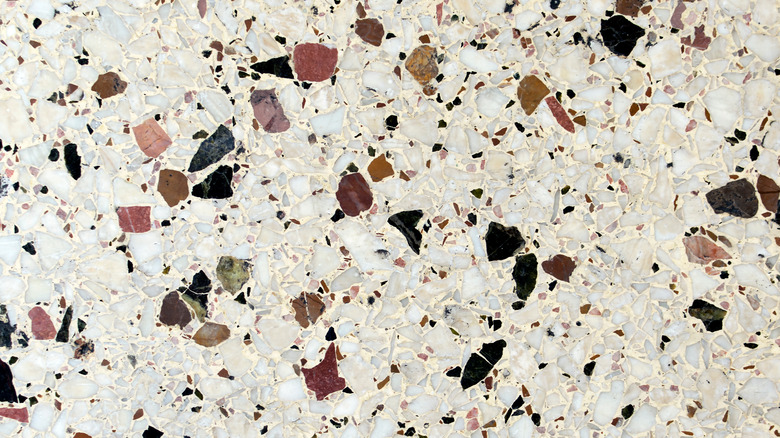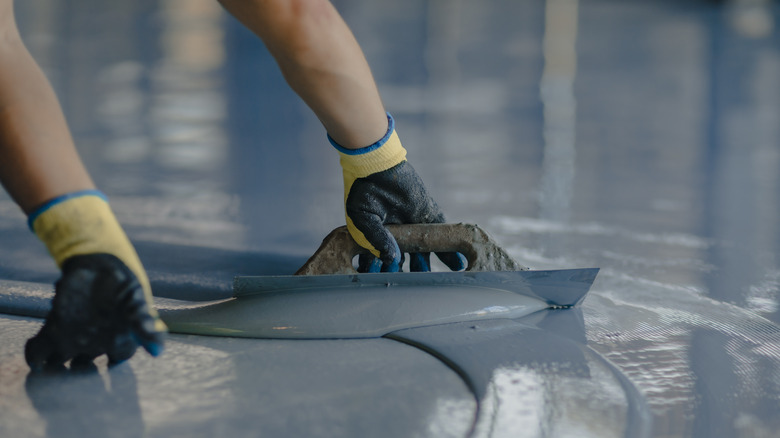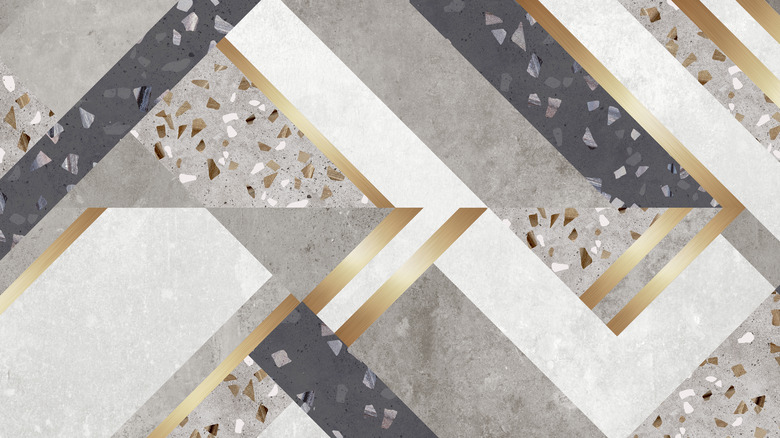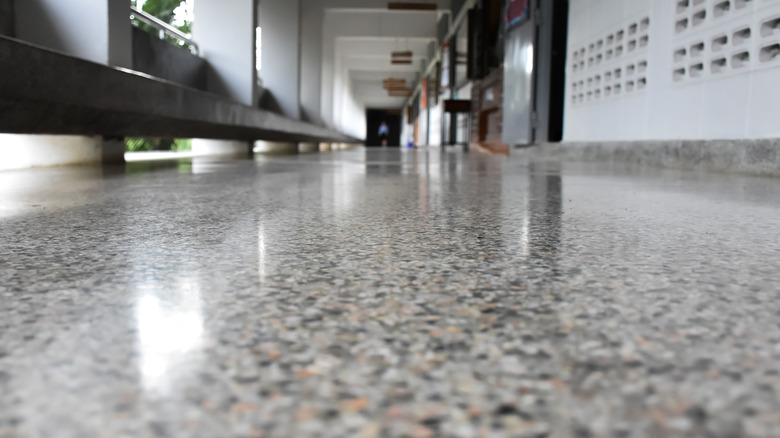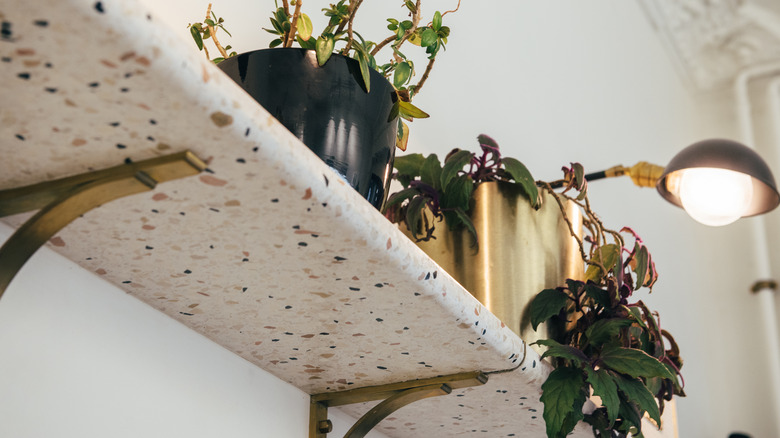What Is Terrazzo Flooring?
Want Mediterranean flair without moving to Italy? Commonly seen in businesses or homes, you might try installing terrazzo flooring in your kitchen, bathroom, or office spaces. Terrazzo is made from a fused material of marble fragments (or aggregate) that have been fixed into cement to form a decorative look. Like mosaics, terrazzo flooring stems from the ancient art form but contains smaller, scattered marble fragments rather than larger pieces that are specifically positioned. The old-world technique originated in Italy over 500 years ago by Venetian workers who combined leftover marble chips from other projects, then placed them in a clay mortar base, per Concord Terrazzo Co. The finished product was often featured in homes and on terraces.
Is terrazzo easy to install? From St. Peter's Basilica to Mount Vernon, even the Hollywood Walk of Fame, terrazzo suits a plethora of places and is a common old-world process yet can be rather labor-intensive. According to Angi, the job is usually best left to professionals. On the plus side, terrazzo floors are durable and easy to clean, without much need to scrub or polish. Its resilient, non-porous base makes it a great choice for high-traffic areas. Terrazzo is versatile by design and excellent for flooring, countertops, backsplashes, or other custom projects. Keep reading to learn more about terrazzo flooring!
Types of terrazzo flooring
Among the many materials and designs of terrazzo, which one is best? The two main types of terrazzo flooring are cement and epoxy resin. Known to be busy track areas, airport terminals, malls, hospitals, and universities often feature cement terrazzo. According to Terrazzo Australian Marble, laying cement terrazzo is a tedious process that requires accuracy, as the flooring can last 60 years or more if done right. Epoxy resin may be a more suitable choice for your home, as it's low-maintenance and adaptable. Perfect for interior spaces like countertops and flooring, epoxy is easily customizable with colors and designs but may not be durable enough for outdoor spaces.
Depending on your style, terrazzo flooring designs can vary from sleek and modern grays and blacks to colorful confetti creations, including geometric shapes or more traditional Mediterranean-inspired patterns. While decorative chips like marble, granite, quartz, glass, or shell can be integrated into concrete and epoxy matrices, porcelain is also a fresh and sustainable way to go, per Tile Bar. Other kinds of terrazzo, like rustic, are best for external areas with pools and fountains, and sand cushion (formerly used residentially) is good for various artworks.
How to install terrazzo flooring
Whether you plan to install terrazzo in flooring or another place like a kitchen backsplash or shower wall, it can be poured into any formation or mold. Depending on the project and size, it may take a few days to a few weeks to complete. Once the existing flooring has been removed, clean and secure the area, including filling in cracks and ensuring it is waterproofed. Thin metal divider strips may be put into place to assist in building the layout. Skilled professionals should mix the terrazzo, which has a ratio of 5:1 of epoxy resin and hardener, per Doyle Dickerson Terrazzo.
While wet, the mixture is spread and leveled out one section at a time, including aggregate placement. As it dries, a heavy roller is applied to condense the rough top after it's dried. Then, a grinder smooths out the surface while a slurry is added to fill any pores. An adjustable speed angle grinder or polisher should be used to help even out any lumps until a reflective look is achieved, per The Craftsman Blog. Finally, the floor is power-polished to a brilliant shine.
How much does terrazzo flooring cost?
The cost to install terrazzo flooring depends upon your project's surface square footage, type of materials, the complexity of the design, and required labor. A typical floor with limited geometric patterns may run from $10 to $25 and $25 to $90 for more intricate inlaid jobs. For example, using different colors in the design with divider strips will inevitably cost more in labor than a solid color. In total, installation may range between $5,000 and $18,000, with an average of $7,000 for a 200-square-foot surface, per Home Advisor. Terrazzo tile is another budget-friendly option for small residential projects, as its' slightly cheaper than the poured terrazzo route (whether cement or epoxy).
Overall, epoxy resin is cheaper than cement as it's easy to manage, takes less time to prepare (combined with aggregate), and is more outlasting for interior floors. While cement is more costly due to its weight and rigorous demand, it is a top binder for exterior purposes. Additionally, find an authentic contractor specializing in terrazzo installation to limit any hesitation, preferably local, as this can cut down the cost of travel expenses, per Fotolog.
How to care for terrazzo floors
Once your terrazzo is installed, maintaining it is fairly easy. You can go over it with a dust mop each day if needed and clean up any messes or spills as they happen. You might also use a simple steam mop to glide over the top or a small nylon scrub brush to remove any unwanted debris.
To prevent further issues with stains, you might seal the floor with a semi-annually water-based sealant that follows the manufacturer's instructions. According to Elle Decoration, poured terrazzo is more likely to crack than slabs or tiles. If you encounter any minor cracks and want to save on time and money, you could try applying an epoxy patch repair product, which will also help avert the widening of a flaw. Additionally, divider strips can prevent and repair cracks, which are often included with the initial installation, although designers may avoid their inclusion.
Other places you might DIY with terrazzo
If you want to experiment with terrazzo a step further, you could also mold the aggregate into a piece of furniture or other housewares like a bathtub, sink, or side table. In making a small end table, Charleston Crafted suggests using concrete mix while combining it with water until you get a thick, peanut butter-like consistency, then add it to your table set up and marble or glass shards to dry (upside down). From there, you can apply more layers of concrete using a mesh piece to smooth it all down, then let it dry for several hours. Terrazzo also retains heat well, as installing it underneath the floor creates an additional heating source.
With endless versatility, terrazzo may extend as a modern design throughout different places and pieces of your home. Since authentic chips or terrazzo can be costly, you can get creative by making your own faux terrazzo to revitalize and decorate old pieces like a clock, small table, or shelf, per Elysia English. To create your terrazzo chips, paint the colors of your choice onto wax paper and let them dry for a few hours; the combinations of colors are endless with this kind of project. Then chip off, break apart the pieces, and place them on your surface. English applies clear polyurethane with a paintbrush before positioning the pieces.

